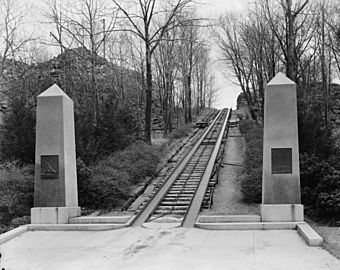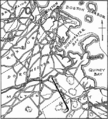Granite Railway facts for kids
Quick facts for kids Quincy Granite Railway |
|
|---|---|
| Commercial operations | |
| Original gauge | 5 ft (1,524 mm) |
| Preserved operations | |
| Preserved gauge | 5 ft (1,524 mm) |
|
Quincy Granite Railway Incline
|
|

The Incline section of the Granite Railway
Quincy (1934 photo) |
|
| Location | Mullin Ave., Quincy, Massachusetts |
|---|---|
| Area | 0.2 acres (0.08 ha) |
| Built | 1826 |
| NRHP reference No. | 73000310 |
|
Quincy Granite Railway
|
|
| Location | Bunker Hill Lane, Quincy, Massachusetts |
| Area | 0.7 acres (0.3 ha) |
| Built | 1826 |
| NRHP reference No. | 73000309 |
| Added to NRHP | October 15, 1973 |
| Added to NRHP | June 19, 1973 |
The Granite Railway was one of the first railroads built in the United States. It was created to move heavy granite stone from Quincy, Massachusetts, to a dock on the Neponset River in Milton. From there, boats carried the stone to Charlestown. This stone was used to build the famous Bunker Hill Monument.
Many people consider the Granite Railway to be the first commercial railroad in the U.S. This is because it was the first railway to get a special permission (a charter) and then grow into a public transportation system without ever closing down. The last active stone quarry connected to the railway closed in 1963. Later, in 1985, a state agency bought about 22 acres of land. This land included the old Granite Railway Quarry, which is now part of the Quincy Quarries Reservation.
History of the Granite Railway
Building the First Commercial Railroad
In 1825, a man named Solomon Willard searched all over New England for the best stone. He chose a site in Quincy to get the granite for the Bunker Hill Monument. After some delays, the Granite Railway Company received its official permission (charter) on March 4, 1826. This permission allowed them to build their railway path.
A businessman and politician named Thomas Handasyd Perkins helped fund the new company. He owned most of its shares and became its president. The railway was designed and built by a railway expert named Gridley Bryant. It started running on October 7, 1826. Bryant used ideas from railways already in use in England. However, he changed his design to carry heavier loads and handle the deep frost in the area.
How the Railway Worked
The railway stretched about 3 miles (4.8 km) from the quarries to the Neponset River. Its wagons had large wheels, about 6 feet (1.8 meters) across. Horses pulled these wagons. This was even though steam locomotives had been used in England for 13 years already.
The railway tracks were made of wood covered with iron. They were laid 5 feet (1.5 meters) apart. Stone blocks were placed every 8 feet (2.4 meters) to support the tracks. By 1837, these wooden tracks were replaced with granite rails, which were also topped with iron.
The Incline Section
In 1830, a new part of the railway was added called the Incline. This section helped move granite from the Pine Ledge Quarry down to the main railway level, which was 84 feet (25.6 meters) below. Wagons moved up and down this 315-foot (96-meter) long incline like a continuous conveyor belt. The Incline kept working until the 1940s.
New Inventions and Visitors
The Granite Railway introduced several important new ideas. These included railway switches (also called frogs), the turntable, and special railroad cars with two sets of wheels (double-truck cars). Gridley Bryant, the designer, never patented his inventions. He believed his ideas should be free for everyone to use and benefit from.
The new railroad was very exciting and attracted many visitors. People traveled from Boston just to see this amazing new technology. Famous guests like politician Daniel Webster and English actress Fanny Kemble came to see it. Miss Kemble even wrote about her visit in her journal in 1833.
An Early Railway Accident
The Granite Railway was also the site of one of the first deadly railway accidents in the United States. This happened on July 25, 1832. A wagon carrying four tourists, including Thomas B. Achuas from Cuba, went off the tracks. The accident happened when the empty wagon was going back up the Incline, and a cable broke. The people in the wagon were thrown about 35 feet (10.7 meters) over a cliff. Sadly, Mr. Achuas died, and the other three passengers were badly hurt.
Changes Over Time
In 1871, the Old Colony and Newport Railway took over the original path of the Granite Railway. They replaced the old tracks with newer ones. This allowed steam trains to carry granite directly from the quarries to Boston. There was no longer a need to use barges from the Neponset River. This part of the Old Colony Railroad later became part of the New York, New Haven and Hartford Railroad.
In the early 1900s, metal channels were put over the old granite rails on the Incline. Motor trucks were then pulled up and down by a cable. Passenger train service on this line ended on September 30, 1940. Freight service (carrying goods) was stopped in stages between 1941 and 1973. Most of the railway's original path was later used to build parts of the Southeast Expressway in Milton and Quincy.
Preserving History
Historic Designations
Parts of the Granite Railway are now protected as historic sites. The railway's Incline was added to the National Register of Historic Places on June 19, 1973. A remaining section of the old railroad bed, near Bunker Hill Lane, was added on October 15, 1973.
Memorials and Displays
In East Milton Square, there is a special display. It includes a historic plaque from 1926, an original railway switch (frog), a piece of train track, and a part of the railway's structure. This frog was even shown at the World's Columbian Exposition in Chicago in 1893. The display is located where the railway used to pass through Milton on its way to the Neponset River.
Visiting the Old Railway Today
In Quincy, you can walk along several park trails that show parts of the original railway. You can see where the railway trestle (a bridge-like structure) and the Incline used to be. These trails connect to the old quarries. Most of these quarries are now filled in with dirt. This was done for safety, using dirt from the huge Big Dig highway project in Boston. In the past, many people were hurt or even died by diving into the flooded abandoned quarries from high places.
The Department of Conservation and Recreation manages the Quincy Quarries Reservation. This area offers places for rock climbing and trails that connect to the remains of the Granite Railway.
Gallery
Images for kids








